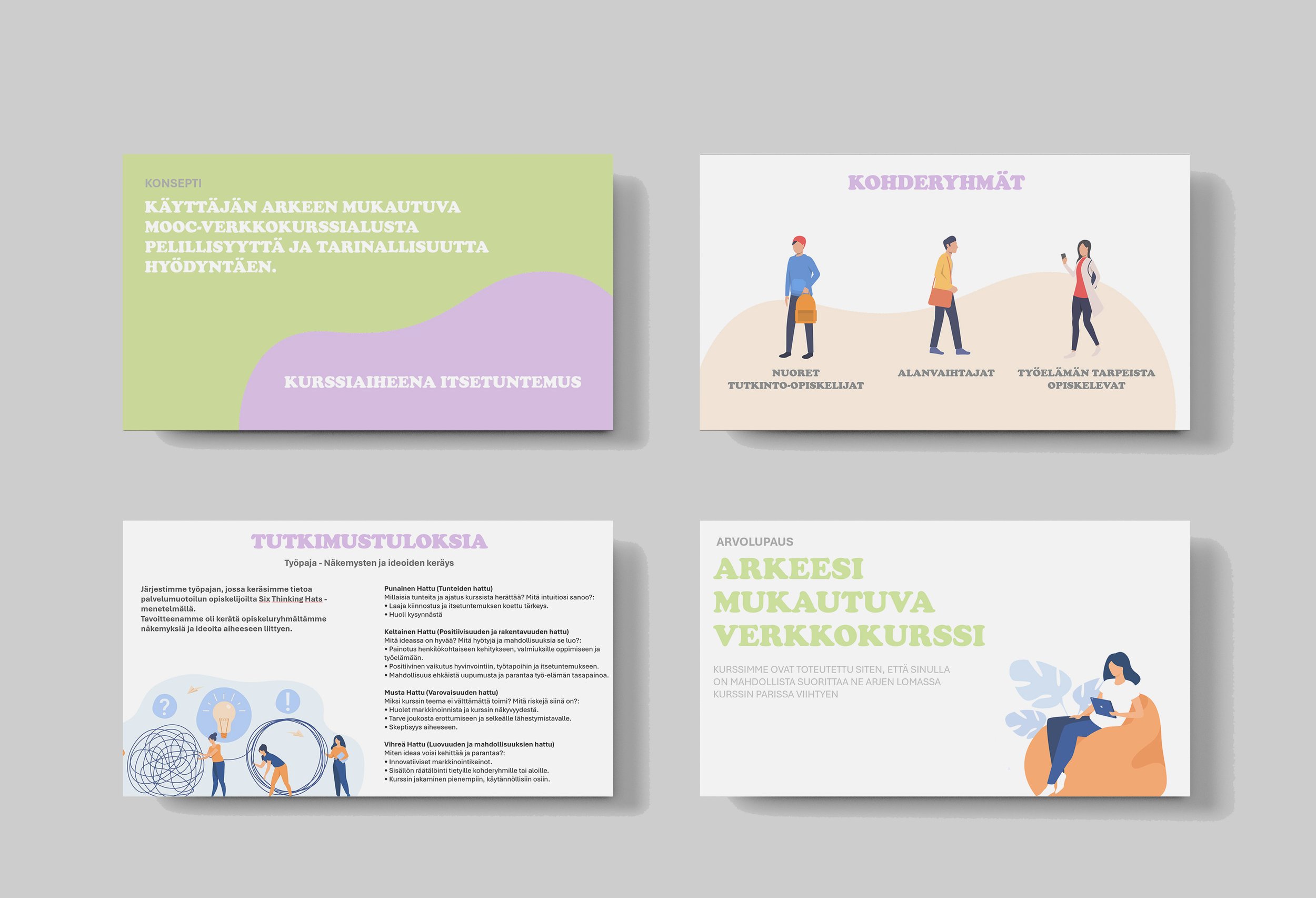
ONLINE COURSES THAT BLEND INTO EVERYDAY LIFE
Savonia University of Applied Sciences wanted to participate in offering MOOC (Massive online open courses) and our task was to develop a concept that stands out from competitors.

University of applied sciences studies 2023
Savonia University of Applied Sciences
PROJECT INFO
Noora Heikkinen
Mona Leppäharju
Niina Lyytikäinen
Janika Tamminen
TEAM MEMBERS
User research, market research, workshop design, facilitation, graphic design, presentation design
MY PROVIDED EXPERTISE
Desk research, benchmarking, competitor analysis, workshop, six thinking hats, in-depth interviews, user testing, brainstorming, customer profile, prototype, value proposition canvas
USED METHODS
CHALLENGE
Over the past few years, traditional degree education has become less easily accessible to everyone. Short, micro-education programs are needed to meet the additional training needs of businesses, as well as individuals' personal desire to learn new things and develop as individuals.
How could Savonia University of Applied Sciences respond to this need and stand out from competitors?
Savonia aimed to explore the future global demand for MOOC-based training concepts.
Three global themes were identified for development, all of which are linked to Savonia's broader international educational cooperation: Future of Work, Green Economy, and Healthy Living.
EMPATHIZE
We began immersing ourselves in the project by exploring the world of MOOC courses and contemplating what the service should entail. We delved into the user personas of online courses through desk research.
Simultaneously, we aimed to identify major global challenges and themes to which our course topics could respond. We pinpointed a topic that relates to both the Future of Work and Healthy Living themes: Self-awareness.
We organized a remote workshop for our fellow students and sought to gain further insights from them on Self-awareness as a course topic. During the workshop, we utilized the Six Thinking Hats method. Following this method, we gathered perspectives from emotional, constructive, and cautious viewpoints. We analyzed the data obtained and decided to proceed with user interviews, taking into account the concerns raised during the workshop:
Does the topic have novelty value?
How can we engage students in the course?
What kind of tasks genuinely lead to self-discovery?
Developing self-awareness takes time. How can we address this in a short course?
How can we create a course that is feasible alongside everyday commitments?
Based on desk research, we defined target groups for the course topic and interviewed 11 representatives of these target groups to ascertain their views on the topic and their needs regarding online courses. I also interviewed a coach specialized in self-awareness coaching.
DEFINE
Based on the interviews, we confirmed the demand for the topic of self-awareness. We could differentiate ourselves from competitors by offering a higher education-level course focusing on self-awareness.
Utilizing both desk research and interview data, we identified the following user groups for our course:
Degree-seeking students
Professionals seeking personal development
Career changers
We also drafted value propositions for each user group.
The interviews provided valuable insights into the development of the course concept itself. The online course should be flexible, engaging, and easily integrated into daily life.
We benchmarked various course websites and applications to establish our own guidelines
IDEATE
Drawing from insights gathered through interviews and benchmarking, we created a service concept:
A MOOC ONLINE COURSE PLATFORM THAT ADAPTS TO USER'S DAILY LIFE, UTILIZING GAMIFICATION AND STORYTELLING.
The MOOC courses designed according to this concept are implemented in a web application style, allowing users to access the entire course conveniently through their phones.
In course delivery, storytelling and gamification are employed. Storytelling elements aim to create engaging content that users are motivated to complete, while gamification is utilized for its entertainment value and addictive nature.
Courses consist solely of tasks where responses are entered directly into answer fields, eliminating the need to produce separate files. This facilitates the integration of the course into users' daily routines. Educational materials are presented in video, audio, and podcast formats to make learning as effortless as possible, with a deliberate avoidance of text-based materials.
PROTOTYPE & TEST
Utilizing Figma, we designed a prototype to explore and test our ideas. While brainstorming and refining the prototype collaboratively within our team, the execution of the prototype itself was created by Niina Lyytikäinen.
Furthermore, we conducted two expert interviews, which served as pivotal inputs for further refining and evolving the course platform.
In the final stages of the concept development, we organized a workshop for our fellow students focusing on self-awareness. Our aim was to test two self-awareness exercises with the goal of gathering feedback for Savonia's MOOC working group for potential further development of the course.
Additionally, we created a video presentation of the concept for Savonia's MOOC working group, wherein we also outlined the value proposition of our concept for Savonia University of Applied Sciences.





